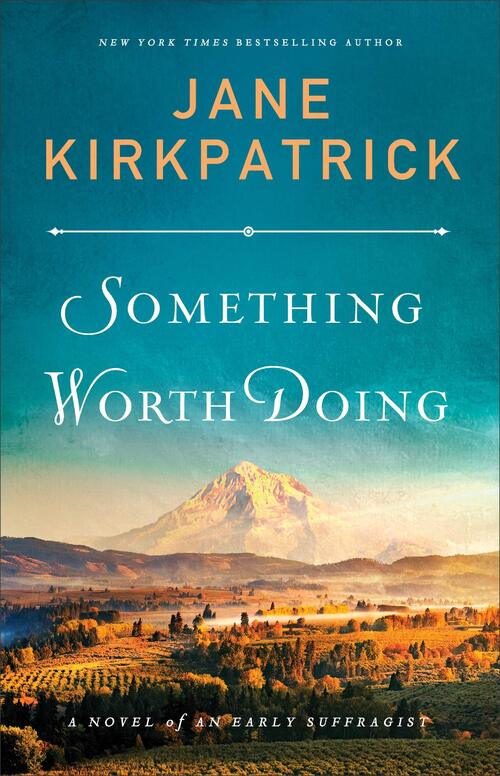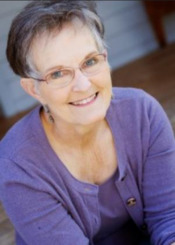1–What’s the name of your latest release?
Something Worth Doing published by Revell. The title comes from a definition of hope by Vaclav Havel, a writer and first president of the Czech Republic.
2–What is it about?
On the surface, it’s about an early suffragist in the northwest named Abigail Scott Duniway and her passion for improving the lives of women in a time when women were to be seen and not heard (1850s-1890s). At another level, it’s about a woman wanting both a career as a novelist (she wrote 22!) and newspaper owner and to be a faithful wife and mother (they had six children!) while maintaining her reputation in a time of great cultural change and the challenges those two goals can have.
3–What word best describes your main character(s)?
Resilient.
4–What makes your story relatable?
Many modern couples struggle with balancing family and callings, supporting each other while facing trials. Long-distance relationships are also prevalent now and Abigail often was away from her home for weeks at a time doing something worth doing. How that worked for them I think will be of interest to today’s readers. There’s also a bit of family tension as Abigail’s brother was the editor of the Oregonian newspaper that made them rivals. We may not have that professional dynamic to deal with, but there are usually sibling challenges in most modern families.
5–Who are the people your main characters turn to when they need help?
Family. First Ben, Abigail’s husband, a man with a great singing voice who adored his wife despite her sometimes rough edges. Her sisters, especially Kate who worked for her on the newspaper. Her friends, Shirley Ellis most of all whom she’d met on the trail crossing the continent in 1852. Shirley could give Abigail perspective when her enthusiasm for the vote brought on diplomatic crises that affected both the fight for the vote and family.
6–What do you love about the setting of your book?
The poet Rainer Maria Rilke once said “I describe myself as a landscape studied at length and in detail…or like a word I am coming to understand.” The Northwest is such a landscape that offers so many variations from mountains to rivers, to deserts to the oceans that invite exploration and cherishing and a “coming to understand.” My characters have to come to terms with the landscapes they interact with. Some are encouraged by the vastness and others find themselves frightened by the bigness. Abigail loved the mountains and didn’t even mind the uncomfortable stagecoaches she had to take to make her speeches on behalf of women because she loved seeing new frontiers. Northwest landscape images permeated her speeches. She drew strength from creation.
7–Are you a plotter (follow an outline) or a pantster (write by the seat of your pants)?
I’m a hybrid. I do have an outline or timeline of when certain events happened in a character’s life and I know usually what will be the moment of despair and the moment of triumph and where the story will end. But this often changes as I write away!
8–What is an ideal writing day for you?
Rising at 5:00am, working until 7:00am. Having breakfast, helping my husband who has health issues get settled for his day, then around 10:00 back to the computer, breaking at 1:00 then back at it at 2:00 until 4:00. Using another gauge, an ideal day is when I write and write and forget about the time because I am inside the story being led along by my characters who are telling the story faster than I can type!
9–Do you listen to music while you write, need total silence, or do you have the TV on?
Almost always silence. But if music is a part of the storyline, I’ll play musical pieces that speak to that usually before I start writing for the day, but rarely during.
10– How do you approach research?
Over the years I’ve developed a three-prong approach. First, I read everything I can about the subject, the setting, the culture, fashion, etc. I try to read things written during the time of my story. It’s an immersion experience and I keep researching and start writing even before I think I should. Second, I look at ephemera, pieces of the historical record that are neither maps nor documents but rather artifacts. I love Antique Roadshow because they often have items from the period I’m writing about and details of a certain kind of jewelry box or the covering of a chair can bring readers into the story. I identify artifacts for my characters making them authentic to the character and the time…at least I hope so. And finally, “Go there.” That’s my third prong, to go to the places where the story takes place. Because travel can be a problem (and it’s costly) I also engage fans/friends in the area and on a given day I will email them and say “What’s your weather like this September day?” or “What can you hear outside your window, what can you smell, what can you see.” It’s not as good as “going there” walking where a character might have walked but it has been a gift to hopefully give readers the sense that they have been to this place.
11—What is your publishing journey story?
I worked as the director of a mental health facility when I took two writing courses at the local community college. I began writing and selling short non-fiction pieces for magazines and newspapers, seeing my words appear in over 50 publications varying from Mother Earth News to Private Pilot. In the early 1980s, my husband and I left our occupations and moved to 160 remote acres of what I called “Rattlesnake and Rock Ranch.” My first published book was a memoir about that grand adventure called Homestead where we ranched for 27 years. I kept writing non-fiction for magazines and newspapers until a story found me and wouldn’t let me go. Four years later in 1995, my first novel was published, A Sweetness to the Soul and it happily won a national award. I signed a contract for three more books about historical frontier couples and then signed a contract for three more and then three more etc. I’ve written short stories for collections, gift books for grief, and other non-fiction books. But being a novelist, telling stories of forgotten pioneer women has been my path to now more than 30 novels. I’m contracted out for two more.
12–Do you have critique partners/writing groups you want to give a shout-out to?
Women Writing the West members have been my tribe for years. The non-profit holds annual conferences and otherwise we “gather” via the internet. Its members are great women and men who care about quality writing about the woman’s experience in the west. Children’s stories, creative non-fiction, contemporary, historical, and trade paperback authors, too. They are great resources for research and even more for carrying on when one gets the inevitable rejection. www.womenwritingthewest.org
13–What’re the most frustrating things about being an author?
The marketing and trying to get our stories out there. As a mid-list author, it’s hard labor to find readers one book at a time but for many of us, that’s the route. I like scheduling events where I can tell stories about the book, the research, hoping to touch contemporary lives with my historical stories and encourage the writers in the crowd. That’s my best marketing strategy. I’m grateful to publishers and publicists for keeping our titles out there. With Covid-19, being “out there” with fans hasn’t been able to happen so I’m learning new ways of marketing.
14–What’s your favorite scent?
I would have said lavender but I got some Frankincense to burn as incense and I think I like it more!
15–What movie will you watch no matter what if it’s on TV?
Tootsie.
16–Do you like breakfast, lunch, or dinner best?
Breakfast if it can be a gathering around bacon and eggs and fruit 🙂
17–What’s one thing you wish you knew more about?
Copy editing so I wouldn’t put my copy editors through such strain managing my commas.
18–What’s the silliest thing you’ve recently done?
Blew bubbles on the belly of our Cavalier King Charles Spaniel the way I would on a baby’s belly. He loved it!
19–What can readers expect from you next?
I’m currently working on a novel about a classically trained musician who lost herself the night before a major performance and found herself years later on the Southwest desert capturing for posterity the music of Native Americans, all in the early 1900s.
20–How can readers reach you?
They can sign up for my Story Sparks newsletter at www.jkbooks.com and read about upcoming releases and events there and hopefully find inspiration for difficult days. At my website jkbooks.com, visitors can leave messages that come directly to me and I try very hard to always respond if only a few sentences of gratitude. I’m also on Facebook, Bookbub, Goodreads and other social media sites.
#PioneeringWomen
#JaneKirkpatrick
#Somethingworthdoing
SOMETHING WORTH DOING by Jane Kirkpatrick
A Novel of an Early Suffragist
In 1853, Abigail Scott was a 19-year-old school teacher in Oregon Territory when she married Ben Duniway. Marriage meant giving up on teaching, but Abigail always believed she was meant to be more than a good wife and mother. When financial mistakes and an injury force Ben to stop working, Abigail becomes the primary breadwinner for her growing family. What she sees as a working woman appalls her, and she devotes her life to fighting for the rights of women, including their right to vote.
Following Abigail as she bears six children, runs a millinery and a private school, helps on the farm, writes novels, gives speeches, and eventually runs a newspaper supporting women’s suffrage, Something Worth Doing explores issues that will resonate strongly with modern women: the pull between career and family, finding one’s place in the public sphere, and dealing with frustrations and prejudices women encounter when they compete in male-dominated spaces. Based on a true story of a pioneer for women’s rights from award-winning author Jane Kirkpatrick will inspire you to believe that some things are worth doing–even when the cost is great.
Romance Historical | Inspirational Historical [Revell, On Sale: September 1, 2020, Paperback / e-Book, ISBN: 9780800736118 / ]
Buy SOMETHING WORTH DOING: Amazon.com | Kindle
| BN.com | Powell’s Books | Books-A-Million | Indie BookShops | Ripped Bodice | Love’s Sweet Arrow |
Walmart.com
| Book Depository | Target.com | Amazon CA | Amazon UK | Amazon DE | Amazon FR
About Jane Kirkpatrick
A New York Times Bestselling author, Jane Kirkpatrick’s works have appeared in more than 50 national publications including The Oregonian, Private Pilot, and Daily Guideposts. With more than 1.5 million books in print, her 30 novels and non-fiction titles draw readers from all ages and genders. Most are historical novels based on the lives of actual historical women often about ordinary women who lived extraordinary lives. Her works have won numerous national awards including the WILLA Literary Award, the Carol Award, USABestBooks.com, Will Roger’s Medallion Award, and in 1996, her first novel, A Sweetness to the Soul, won the prestigious Wrangler Award from the Western Heritage and National Cowboy Museum. Her novels have also been finalists for the Spur Award, the Oregon Book Award, the Christy, Reader’s Choice, and the WILLA in both fiction and non-fiction. Several titles have been Literary Guild and Book of the Month choices and been on the bestsellers list for independent bookstores across the country, in the Pacific Northwest and the Christian Booksellers Association. Her books have been translated into German, Dutch, Finnish, and Chinese.




No Comments
Comments are closed.